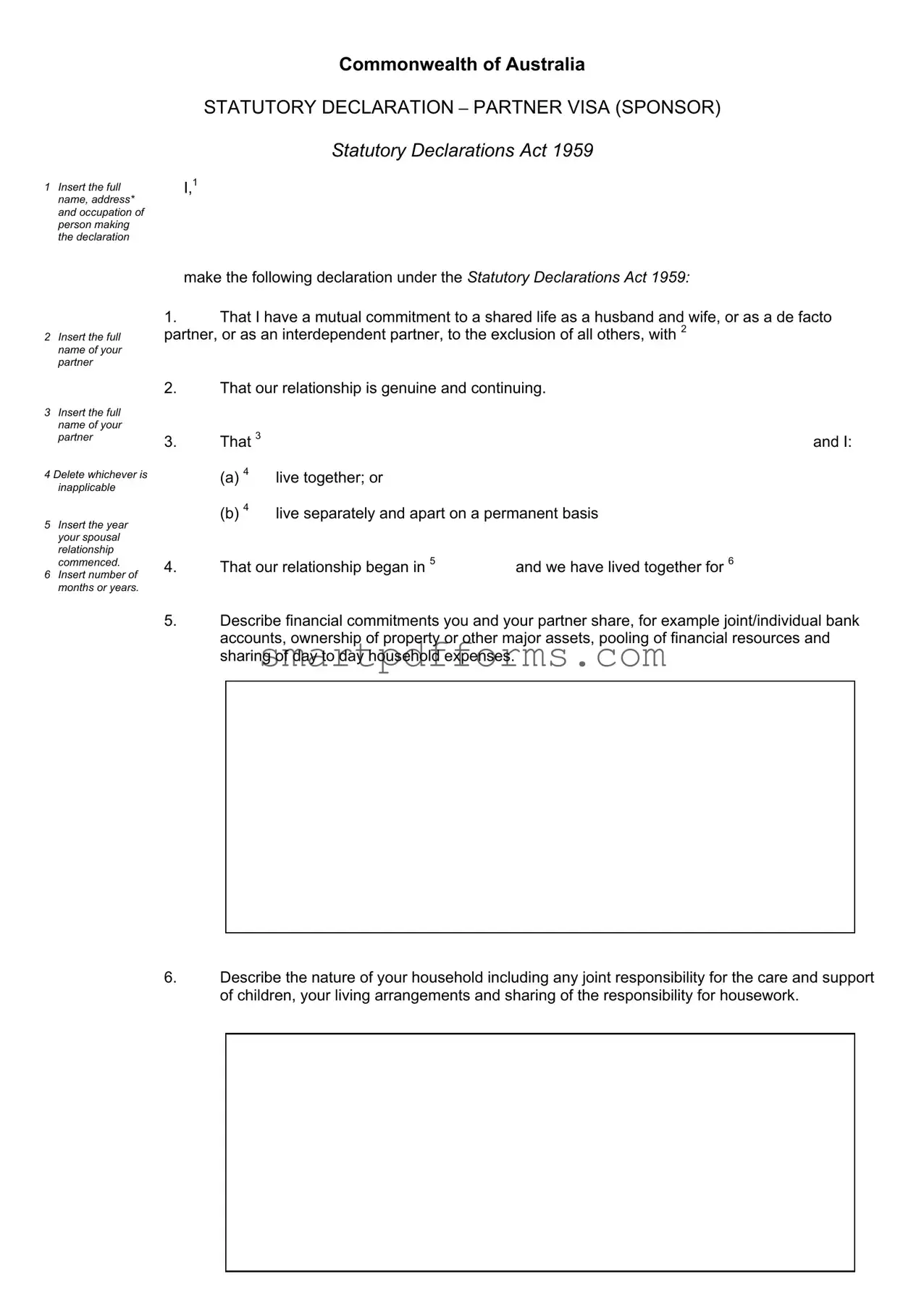Commonwealth of Australia
STATUTORY DECLARATION – PARTNER VISA (SPONSOR)
Statutory Declarations Act 1959
name, address* and occupation of person making the declaration
2Insert the full name of your partner
make the following declaration under the Statutory Declarations Act 1959:
1.That I have a mutual commitment to a shared life as a husband and wife, or as a de facto partner, or as an interdependent partner, to the exclusion of all others, with 2
3Insert the full name of your partner
4 Delete whichever is inapplicable
5Insert the year your spousal relationship commenced.
6Insert number of months or years.
2.That our relationship is genuine and continuing.
3. |
That 3 |
|
and I: |
|
(a) 4 |
live together; or |
|
|
(b) 4 |
live separately and apart on a permanent basis |
4. |
That our relationship began in 5 |
and we have lived together for 6 |
5.Describe financial commitments you and your partner share, for example joint/individual bank accounts, ownership of property or other major assets, pooling of financial resources and sharing of day to day household expenses.
6.Describe the nature of your household including any joint responsibility for the care and support of children, your living arrangements and sharing of the responsibility for housework.
7.Describe the social aspects of your relationship including social activities, attending special events or joint travel you and your partner undertake.
8.Describe the nature of your commitment to each other including the degree of companionship and emotional support you draw from each other and whether you see the relationship as a long-term one.
I understand that a person who intentionally makes a false statement in a statutory declaration is guilty of an offence under section 11 of the Statutory Declarations Act 1959, and I believe that the statements in this declaration are true in every particular.
7Signature of person making the declaration
8 Place
9Day (eg, sixth)
10 Month and year
11 Insert the full name of person before whom the declaration is made (see over)
12 Signature of person before whom the declaration is made
13 Full name, qualification and address* of person before whom the declaration is made (in printed letters)
Note 1 A person who intentionally makes a false statement in a statutory declaration is guilty of an offence, the punishment for which is imprisonment for a term of 4 years — see section 11 of the Statutory Declarations Act 1959.
Note 2 Chapter 2 of the Criminal Code applies to all offences against the Statutory Declarations Act 1959 — see section 5A of the Statutory Declarations Act 1959.
*"address" means the place at which, or through which, a person may be contacted, and includes a postal address, but does not include the person’s email address.
A statutory declaration under the Statutory Declarations Act 1959 may be made before–
(1) a person who is currently licensed or registered under a law to practise in one of the following occupations:
Chiropractor |
Dentist |
Legal practitioner |
Medical practitioner |
Nurse |
Optometrist |
Patent attorney |
Pharmacist |
Physiotherapist |
Psychologist |
Trade marks attorney |
Veterinary surgeon |
(2)a person who is enrolled on the roll of the Supreme Court of a State or Territory, or the High Court of Australia, as a legal practitioner (however described); or
(3)a person who is in the following list:
Agent of the Australian Postal Corporation who is in charge of an office supplying postal services to the public
Australian Consular Officer or Australian Diplomatic Officer (within the meaning of the Consular Fees Act 1955)
Bailiff
Bank officer with 5 or more continuous years of service
Building society officer with 5 or more years of continuous service
Chief executive officer of a Commonwealth court
Clerk of a court
Commissioner for Affidavits
Commissioner for Declarations
Credit union officer with 5 or more years of continuous service
Employee of the Australian Trade Commission who is:
(a)in a country or place outside Australia; and
(b)authorised under paragraph 3 (d) of the Consular Fees Act 1955; and
(c)exercising his or her function in that place
Employee of the Commonwealth who is:
(a)in a country or place outside Australia; and
(b)authorised under paragraph 3 (c) of the Consular Fees Act 1955; and
(c)exercising his or her function in that place
Fellow of the National Tax Accountants’ Association
Finance company officer with 5 or more years of continuous service
Holder of a statutory office not specified in another item in this list
Judge of a court
Justice of the Peace
Magistrate
Marriage celebrant registered under Subdivision C of Division 1 of Part IV of the Marriage Act 1961
Master of a court
Member of Chartered Secretaries Australia
Member of Engineers Australia, other than at the grade of student
Member of the Association of Taxation and Management Accountants
Member of the Australasian Institute of Mining and Metallurgy
Member of the Australian Defence Force who is:
(a)an officer; or
(b)a non-commissioned officer within the meaning of the Defence Force Discipline Act 1982 with 5 or more years of continuous service; or
(c)a warrant officer within the meaning of that Act
Member of the Institute of Chartered Accountants in Australia, the Australian Society of Certified Practising Accountants or the National Institute of Accountants
Member of:
(a)the Parliament of the Commonwealth; or
(b)the Parliament of a State; or
(c)a Territory legislature; or
(d)a local government authority of a State or Territory
Minister of religion registered under Subdivision A of Division 1 of Part IV of the Marriage Act 1961
Notary public
Permanent employee of the Australian Postal Corporation with 5 or more years of continuous service who is employed in an office supplying postal services to the public
Permanent employee of:
(a)the Commonwealth or a Commonwealth authority; or
(b)a State or Territory or a State or Territory authority; or
(c)a local government authority;
with 5 or more years of continuous service who is not specified in another item in this list
Person before whom a statutory declaration may be made under the law of the State or Territory in which the declaration is made Police officer
Registrar, or Deputy Registrar, of a court
Senior Executive Service employee of:
(a)the Commonwealth or a Commonwealth authority; or
(b)a State or Territory or a State or Territory authority
Sheriff Sheriff’s officer
Teacher employed on a full-time basis at a school or tertiary education institution


